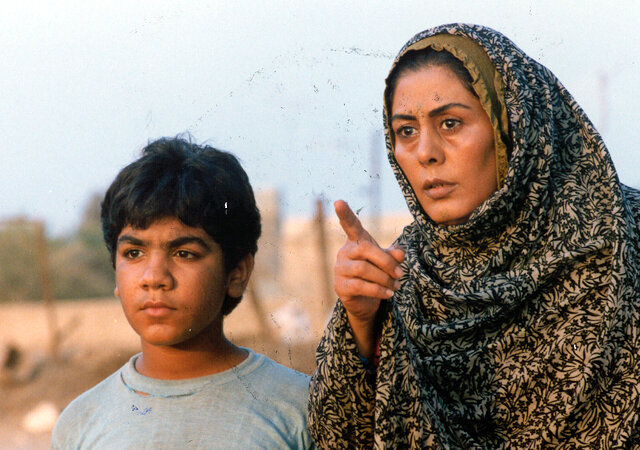Portrayal of Ashura through the lens of Iranian cinema: Part 6

TEHRAN – While there have been plenty of films and TV series that have directly portray the historical events of Ashura, a number of filmmakers have chosen a different path.
They have embarked on a journey to create captivating films that delve into the influence of Ashura culture on the lives of contemporary individuals.
These movies are set in a contemporary backdrop, revolving around families, with each one having a special connection to the story of Imam Hussein (AS) and Ashura.
One notable example is the heartfelt and poignant film, “For The Sake Of Hanieh”, which was directed by the celebrated Iranian director Kiumars Purahmad in 1995.
The film tells the tale of Captain Olov, a resident of a small village in southern Iran. The story unfolds when Olov ventures out to sea for a fishing expedition with 14 other men, only to be the sole survivor upon their return.
In the aftermath of the tragic accident, the villagers direct their blame towards Olov, holding him responsible for the loss of their beloved ones. The once tight-knit community becomes divided, with Olov's family bearing the brunt of their anger and resentment. Faced with relentless condemnation, Olov and his family are left with no choice but to seek refuge in Bushehr, leaving their old life behind.
The story takes an unexpected turn as Captain Olov passes away. Hanieh, Olov's daughter, is paralyzed. Prior to his passing, Olov made a solemn promise to perform Dammam, a large double-headed cylinder drum played in religious ceremonies, in a Muharram night, beseeching God for her well-being, but his untimely demise leaves this promise unfulfilled.
Now burdened with the responsibility of honoring his father's vow, Bashiro, Captain Olov's teenage son, steps forward. He tries to convince Zair Khezr, the owner of the Dammam, to entrust him with the instrument. However, Zair Khezr refused to hand over the Dammam to a young and inexperienced teenager.
Khezr's wife is seeking a crib to host a special ceremony in honor of Ali Asghar (AS), the six-month-old baby boy of Imam Hussein (AS), who was the youngest person martyred in the Battle of Karbala. She firmly believes that a young boy should be the one to fetch the crib for her.
Khezr challenges Bashiro to a bet, promising that if he can journey to their village and retrieve the crib, he will generously reward him with a Dammam, thereby fulfilling his father's promise.
For Bashiro, going to the village is not just a regular trip; it is a daring and treacherous adventure. Along the way, he encounters numerous obstacles and problems. After overcoming countless hardships, Bashiro manages to bring the crib back to Bushehr. But alas, his triumph is short-lived as Khezr, in an unforgivable betrayal, breaks his solemn promise.
Bashiro happens to stumble upon Khezr's Dammam’s storehouse and, despite being wounded and exhausted, he spends the entire night playing Dammam in the hope that it will heal Hanieh.
"For the Sake of Hanieh," can be regarded as one of the most impactful creations on the subject of Ashura. The film vividly portrays the clash between faith and truth, unveiling a world fueled by pretense and deception.
The main character of the film is Bashiro, who embarks on a journey to seek healing for his sister from Imam Hussein (AS) and confront the many challenges along the way. However, he must overcome his greatest obstacle of all: immense cruelty.
Khezr, Bashiro's initial challenge, perceives the Dammam ceremony as a personal achievement rather than a meaningful tribute to the mourning of Imam Hussain (AS). Bashiro must confront a group that unjustly blames his father for the death of their loved ones and seek vengeance for their blood, despite his complete innocence in the matter. However, in the end, it is the power of love and faith that triumphs in this intense confrontation, leading Bashiro towards his ultimate goal.
The film also shows the profound role that faith plays in navigating a society plagued by crises and chaos. Following the demise of his father, Bashiro is compelled to rely on a wheelbarrow to sustain himself. The destitution that befalls Bashiro stands in stark contrast to the opulence of Khezr, who arrogantly assumes the mantle of guardian over the commemoration of Imam Hossein's mourning ceremony.
The director deftly sidesteps revealing Bashiro's adversaries and the ones who torment him in the village scenes, deliberately refraining from exposing any visual depiction of these individuals. With this technique, Bashiro appears to be suffering from an invisible force that inflicts harm upon him.
This oppressive phenomenon is a reflection of the concealed societal oppression. It feels as though Bashiro is battling against a clandestine army of malevolence.
Bashiro readily encounters the obvious and clearly visible obstacles that lie ahead of him on his way to the village. However, upon reaching the village, these obstacles mysteriously vanish from sight, remaining hidden and elusive. This perplexing sequence repeats itself once Bashiro departs the village, as the obstacles resurface, once again becoming visible.
This film technique aims to illustrate how Bashiro is entangled in an endless cycle of blatant oppression and deceit, fervently longing for liberation.
However, it is his unwavering devotion to the truth and his deep love for Imam Hussein (AS) that ultimately serve as his salvation.
To be continued
Photo: A scene from “For The Sake Of Hanieh by Kiumars Purahmad
ABU/
